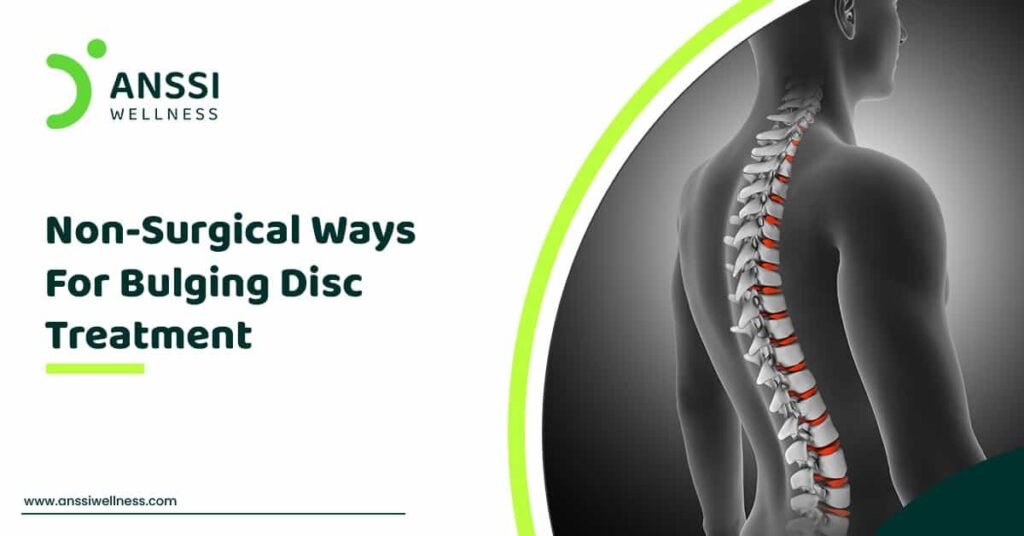Bulging disc is a common condition, particularly in older adults, wherein age-related wear and tear is the main reason. This condition involves a spinal disc expanding beyond its original shape, placing undue pressure on a surrounding nerve root, resulting in back or neck pain.
Today, let’s discuss the difference between a bulging disc and a herniated disc. We will also discuss the various bulging disc symptoms and learn about the causes of a bulging disc and the non-surgical treatments available for bulging disc.
What’s the Difference between a Bulging Disc and a Herniated Disc?
A herniated disc is basically the latter stage of a bulging disc condition. When left untreated, a bulging disc is likely to progress into a herniated disc which is a more severe form of spinal disorder. In the case of a herniated disc, the inner material of a spinal disc actually breaks through the outer protective covering and touches the nearby nerves. In a bulging disc, the outer covering remains intact but still pushes outwards to compress nerves.
As per the American Association of Neurological Surgeons, the correct way to obtain an accurate diagnosis of a bulging/herniated disc is through the symptoms an individual is experiencing, his/her medical history, physical examination, and a diagnostic test.
What Are the Symptoms of a Bulging Disc?
An early diagnosis and subsequent treatment for a bulging disc is key to avoiding it progressing into a herniated disc. Different individuals may experience symptoms of a bulging disc differently. Having said that, the following are the most common symptoms of a bulging disc condition:
- Back pain
- Tingling
- Numbness
- Burning sensation
- Muscle spasms
- Weakness
- Difficulty walking
Causes of a Bulging Disc
The common causes of a bulging disc include:
- Degenerative disc disease leading to spinal osteoarthritis
- Back injury or strain
- Improper posture
- Obesity
- Inactivity
- Smoking
Non-Surgical Treatment for Bulging Disc
Depending on the severe nature of the bulging disc and the accompanying symptoms, different non-surgical treatment options can provide temporary or long-term pain relief. Following are the non-surgical treatment alternatives available for bulging disc.
Physical Therapy
Doctors may prescribe physical therapy comprising exercises, massage, etc. to help boost mobility and range of motion, in addition to enhancing the strength of the back muscles. A qualified physical therapist can suggest the best and suitable exercises for you as per your condition to help reduce back pain by alleviating pressure on the nerve.
Heat or Cold Therapy
In mild cases of bulging disc, ice packs and heating pads can help relieve pain and inflammation, helping to manage the condition in a conservative manner.
Non-Surgical Spinal Decompression Treatment
This advanced form of treatment is designed to treat the root cause of a bulging disc condition. During the non-surgical spinal treatment, the spine is gently stretched to create negative pressure inside the affected region. This allows the disc bulge to retract back in its original position, facilitating healing process in that area. By encouraging the flow of water and nutrients towards the spinal discs, non-surgical spinal treatment offers long-lasting relief from pain.
About ANSSI:
ANSSI Wellness focuses on improving the quality of life for patients suffering from spinal issues, aiming to provide relief where other conventional treatments have failed. Through advanced non-surgical spinal decompression treatment, ANSSI is committed to helping patients avoid surgery and recover in a safe, effective, and compassionate environment.
FAQs
Yes, in many cases, the bulging disc symptoms go away after a period of time.
MRI is the best diagnostic test to detect herniated and bulging discs.
Massage can provide short-term relief from chronic back pain caused by a bulging disc.



